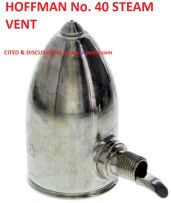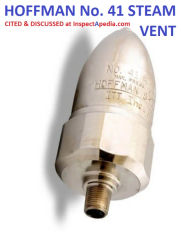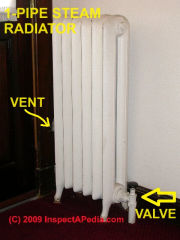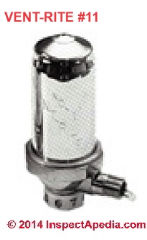 1-Pipe Steam Radiator Vents
1-Pipe Steam Radiator Vents
5 Types used on Steam Heat
Systems
- POST a QUESTION or COMMENT about automatic steam vents on radiators: selection, installation, adjustment, diagnosis & repair
Here we describe the types of vents used on one pipe steam heating systems, including vents that give finer control over the amount of heat being delivered, helping to regulate room temperature as you wish.
We describe simple one pipe steam heat vents as well as more sophisticated adjustable and automatic vents for better control of steam heat output.
This article series answers most questions about all types of steam heating systems and gives important inspection, safety, and repair advice.
InspectAPedia tolerates no conflicts of interest. We have no relationship with advertisers, products, or services discussed at this website.
- Daniel Friedman, Publisher/Editor/Author - See WHO ARE WE?
Automatic or Thermostatically Controlled Steam Vents
When steam is first rising in a one pipe or two pipe steam heating system, the steam heating radiator will be cool as will be the steam vent. The vent lets cool air out of the radiator so that hot steam can enter and heat the radiator and then the room in which the radiator is installed.
Most residential steam vents are low-pressure (1.5 psig) devices. Our photo just above shows a Hoffman No. 40 float-type radiator steam vent that is designed for slightly higher operating pressures (around 6 psi), and for still higher residential steam pressures, similar models include the Hoffman model 70A (11 psig).
[Click to enlarge any image]
These steam vents are found on almost all one-pipe steam heating system radiators, at some locations on steam piping, and in some applications they make a cameo appearance on two-pipe steam heating systems too (where steam traps are more common).
Article Contents - 5 Types of steam vents found on one pipe steam heat systems
By controlling the rate at which a steam radiator gets hot, adjustable steam vents are a key instrument for balancing steam heat in a building. Each of the following steam vent types is discussed in the article below.
- Basic steam vents on one-pipe steam heat systems
are given below at STEAM VENTS on ONE PIPE SYSTEMS - Float-type steam vents:
To stop venting air out of a steam radiator onec it has gotten hot, a water+alcohol-filled float inside the steam vent heats, rises, and closes the vent as the radiator heats.
The float also rises to prevent water from spitting out of the vent should condensate rise inside the radiator or vent.
Rust or sediment can clog the float vent opening and interfere with its proper operation. Excessive steam pressure can also prevent the vent from operating properly. -
Details are on this page at FLOAT-TYPE STEAM VENTS - Thermostatically-controlled no-float steam vents
Details are below on this page at THERMOSTATICALLY-CONTROLLED STEAM VENTS - Adjustable steam vents (photo at the top of this page)
operate similarly to the float-type steam vents described above, but add the feature of adjustable air vent opening size so that the air venting rate can be better matched to the radiator size. (Larger steam radiators need a larger air vent opening.)
Examples: Hoffman Model 1A (Part No. 401422) adjustable air valve with 6 settings (1-slow to 6-fast venting); VariValve® Quick-Vent. Those vents are designed for traditional steam radiators.
If your steam heat is by a steam convector unit, different steam vents are required, such as the Hoffman Specialty Model 1B (Part No. 401425). -
See ADJUSTABLE Steam Radiator Vents below on this page
- Adjustable-Thermostatically-operated
steam vents
include an adjustable room temperature thermostat that allows the occupant to set the desired room temperature. Installing this type of vent on your steam radiator close the functional equivalent of an individual room heat thermostat control at each radiator.
Setting this control actually adjusts the rate at which the steam vent permits air to escape from the individual radiator, similar to the adjustable steam vents described above, but in this case once the thermostat is set, the automatically regulating steam vent is responding to the room temperature setting.
Details are below on this page at ADJUSTABLE THERMOSTATICALLY OPERATED steam radiator valves & vents
and also an alternative dis found on this page:
at THERMOSTATICALLY-CONTROLLED STEAM VENTS
1 Pipe System Steam Vents
Above: a common steam vent, the Hoffman No. 41, that may be found on one pipe steam heat systems that use a convector type "radiator".
Simple Vents on One-Pipe Steam Heat Radiators
On one-pipe steam heat systems the radiator valve is normally fully open (for the radiator to operate properly) or fully shut (no heat); you may find that some one-pipe steam heating system radiators will not work properly if the valve is left "in between" these positions.
Steam rises and enters each heating radiator through a single pipe, pushing air out of the radiator through its vent. Condensate returns to the boiler through the same pipe, passing out through a special passage in the radiator control valve.
Role of the steam vent on one pipe steam heat systems
Unlike radiator valves that are closed manually or automatically to control the entry of hot water or steam into a heating radiator, steam vents are located at the opposite end of the radiator from the valve and are used to vent air out of a steam radiator so that steam can rise into and heat the unit.
When steam reaches and heats the steam vent, the vent is designed to close and stop venting air (or steam), and the radiator will heat.
The steam vent opens, allowing air inside the radiator to be pushed out by rising steam that enters the radiator at the radiator bottom where a radiator valve is present and open.
The "hissing" sound you hear from the steam vent is air being pushed out of the radiator, and is normal. When the steam radiator and steam vent have become warm or hot, the steam vent closes (and is quiet).
Float-type steam vents
As we introduced above, float type steam vents use a water+alcohol-filled float inside the steam vent heats, rises, and closes the vent as the radiator heats.
Above: Vent-Rite No. 51 steam vent.
The float also rises to prevent water from spitting out of the vent should condensate rise inside the radiator or vent. Rust or sediment can clog the float vent opening and interfere with its proper operation.
Excessive steam pressure can also prevent the vent from operating properly.
At STEAM RADIATOR VENT CLEAN & TEST we show the disassembly and inspection of the float-type steam vent shown just above.
Shown above: a Vent-Rite # 11 steam vent intended for 1 pipe steam systems.
Here's the basic difference between the Vent-Rite #1 and #11:
- The Vent-Rite #1 has a 3/32" vent port and operates at 3 psi.
- The Vent-Rite #11 has a 1/16" vent port and operates at 6 psi. So I'm not sure that a #11 is a proper substitute for a #1.
So we see that the difference between the Vent-Rite #1 & #11 is the vent port size and operating pressure.
Thermostatically-controlled no-float steam vents

Watch out: Some "thermostatically operated" steam vents include user-adjustable controls that permit the steam vent to operate as an individual room thermostat.
But watch out: other "thermostatically operated" steam vents may be units that are not adjustable for controlling room temperature. These "thermostatically controlled" vents are describing how the vent works internally, not its function as an occupant-adjustable room temperature control.
Hoffman Specialty heating products offers thermostatically operated steam vents (such as the Hoffman Special Steam Vent Model 3 (Part No. 401419) no internal float, image at left) that can automatically regulate heat from individual steam radiators.
These vents are used for Air Line or Paul Systems. The Hoffman Specialty Thermostatic Temperature Regulators (Series 1140 & 1141) are designed for commercial and institutional HVAC systems. These devices permit a set temperature ranging from 40°F. through 220 °F in increments of 40 °F. (no fine tuning).
Watch out: these steam regulators fail "open" (meaning heat fully on), so Hoffman warns that an alarm or cut-off must be installed where overheated water (or steam) could cause harm. Failure to follow this warning could cause serious burns, personal injury, or death.
For more conventional steam vents, take a look at the Hoffman Specialty series 2000 and the Hoffman Model 3 Steam Air Line Valve (Part No. 401419) for an example.
A Hoffman Vent, Model 3, is also thermostatically controlled, operates on temperature only, and does not close against water. Hoffman also produces conventional steam radiator vents such as their traditional Model 1A air valve, and also the Hoffman Model 74 float operated steam unit heater air valve.
But these vents do not include a readily-accessible temperature adjustment. For steam heating convectors, different steam vent models are required due to the different operating pressures and vent locations that may be present.
Watch out: when replacing a steam vent be sure that you buy the proper vent for your heating radiator or convector type, or that the steam vent specifications of the new steam vent match the old one. Hoffman and other control manufacturers provide selection guidelines for steam vents as well as their other controls.
Adjustable Steam Radiator Vents Permit Adjusting Radiator Vent & Heat-Up Rates
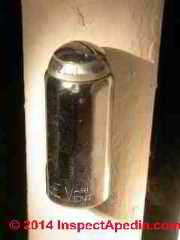 Also as we introduced above, manually adjustable steam vents operate similarly to the float-type steam vents described above, but add the feature of adjustable air vent opening size so that the air venting rate can be better matched to the radiator size. (Larger steam radiators need a larger air vent opening.)
Also as we introduced above, manually adjustable steam vents operate similarly to the float-type steam vents described above, but add the feature of adjustable air vent opening size so that the air venting rate can be better matched to the radiator size. (Larger steam radiators need a larger air vent opening.)
Shown at left: the adjustable VariVent steam radiator vent from VariValve.
Examples of manually adjustable vent-rate steam vents and their steam venting rates include:
- Armstrong Rv-4 One-Pipe Steam Radiator Valve [PDF] available from Armstrong International, 816 Maple Street, Three Rivers, MI 49093 USA, Tel: (269) 273-1415, Web: armstronginternational.com - Armstrong has offices in Beijing, China, Belgium, India and Mexico. Web search 12/27/2010, original source: armstronginternational.com/thermostatic-valves-rv-4-one-pipe.
- Flair #101 steam vents (4 vent rate settings adjust vent rate from 0.00 to about 0.20 CFM
- Gorton steam vents, adjustable depending on model from 0 to 0.4 CFM venting rate.
Gorton Heating Corporation, 546 South Avenue East, Cranford, New Jersey 07016, Tel: 908-276-1323, Web: gorton-valves.com Email: info@gorton-valves.com, fast venting valves for steam heating systems. - Heat Timer VariValve® Quick-Vent from Heat Timer (sliding vent rate adjuster). Those vents are designed for traditional one-pipe steam radiators. Contact: Heat-Timer Corporation, 20 New Dutch Lane Fairfield, NJ 07004 USA, Tel: 973 575 4004 and website: heat-timer.com
According to Heat-Timer, their VariValve steam vent can be adjusted from 0 to 0.72 cubic feet per minute (CFM), faster than other steam vent valves. Radiator vent flow rates were tested at a gauge pressure of 1" W.C.
Quoting from the company's product description:
The function of the radiator air vent is to provide a means for air to be driven out of the radiator as steam enters.
At a given pressure the fill time of a radiator varies proportional to its heat capacity and inversely proportional to the venting capacity of the radiator air vent. It is possible to control the speed at which a radiator will fill with steam by installing a radiator air vent with a certain venting capacity.
Used in this manner, radiator air vents are helpful in evening out the heat distribution in a building. - Heat-Timer.com, retrieved 2015-01-22, original source: http://www.heat-timer.com/varivalve/ - Hoffman Model 1A (Part No. 401422) adjustable air valve with 6 settings (1-slow to 6-fast venting); If your steam heat is by a steam convector unit, different steam vents are required, such as the Hoffman Specialty Model 1B (Part No. 401425). Hoffman steam vents handle 0.00 to about 0.20 CFM venting rates.
also Hoffman #40 or #41 steam vents.
Technical notes:
- Steam radiator vent rates and system pressure:
If your steam system pressures are lower than the 1" W.C. test data above, (as likely the case) the steam radiator vent rates will be slower, but the vent rate relationships among these valves probably will be the same. - Main line air vents
are also used on steam systems to quickly purge air from the main steam pipes ahead of the radiators.
Hoffman, Gorton, and Heat-Timer also provide main line steam vents and automatic or adjustable steam vents for the main lines in steam heating systems.
Especially in a single pipe steam heating system, the venting rate of radiators affects how the heating system works, how quickly heat rises in individual rooms, and the ability to balance the delivery of heat among different building areas.
Adjustable Thermostatically-operated steam vents
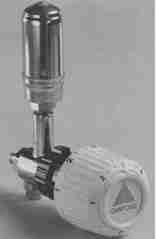 Thermostatically-operated steam vents (shown here) include an adjustable room temperature thermostat that allows the occupant to set the desired room temperature.
Thermostatically-operated steam vents (shown here) include an adjustable room temperature thermostat that allows the occupant to set the desired room temperature.
Setting this control actually adjusts the rate at which the steam vent permits air to escape from the individual radiator, similar to the adjustable steam vents described above, but in this case once the thermostat is set, the automatically regulating steam vent is responding to the room temperature setting.
Some adjustable automatic air vents for steam radiators include:
- Flair #101 variable flow rate steam vents (4 settings) vent from 0.00 to a maximum of about 0.20 CFM [1]
- Gorton air vents - Tel: 908-276-1323 (size the vent to match the radiator)vent from 0.00 to a maximum of about 0.45 CFM across 5 different Gorton steam vent models (#4, #5, #6, #C, #D) and the Gorton #2 steam vent vents to about 0.82 CFM [1] The Gorton company produces both steam radiator vents and main line air vents.
- Heat-Timer.com, "Adjustable Radiator and Main Line Vent Valves for One Pipe Steam Systems, VairValve(R) Lab Study", retrieved 2015-01-22, original source: http://www.heat-timer.com/varivalve/
- Hoffman model 1A, also models Hoffman 40, Hoffman 41, and Hoffman 43 (different piping arrangements) have 6 port settings and operate at a maximum steam pressure of 10 psi (fine for residential systems).
This type of steam valve allows you to adjust how quickly the radiator gets hot; it does not respond to room temperature.
Steam valve vent rates for models Hoffman #1A, #40 #41 were from 0 to about 0.20 CFM while the Hoffman #4A and #75 vent to about 0.70 CFM. [1] The Hoffman company produces both steam radiator vents and main line air vents.
- Hoffman 1A adjustable steam vents, [PDF] available from Hoffman Specialty, ITT, web search 12/27/2010, original source:
http://www.drillspot.com/products/51570/Hoffman_1A_Adjustable_Automatic_Air_Vent_For_Steam_Radiators - Hoffman Convector Steam Vents, [PDF] available from Hoffman Specialty, ITT, web search 12/28/2010, original source:
http://www.hoffmanspecialty.com/pdf/hs900/HS900-conv109.pdf - VariValve ® from Heat Timer Corporation, adjustable steam radiator vent for one pipe steam systems uses a sliding lever on the valve to speed or slow the venting from radiators.
Useful in balancing steam heat distribution in buildings. The VariValve steam vent can vent from 0 to about 0.70 - 0.82 CFM [1]. The Heat-Timer company produces both steam radiator vents and main line air vents.
VariValve® Quick-Vent from Heat Timer [PDF] adjustable radiator and main line vent valves for one pipe steam systems, web search 12/27/2010, original source: http://www.heat-timer.com/enFiles/ProductDocument/literature/VariV056082C.pdf - Vent-Rite #1 Adjustable Air Elimination Steam Vents (Barnes & Jones).
- Watts Water Technologies, Model 0841005_SVA adjustable steam vent
- Webstone air vent valves
Thanks to reader Paul Ruud for discussing improved steam heat controls and thermostatically operated steam radiator valves and air vents.
Watch out: If the radiator continually makes noises (whistling or wheezing) at the steam vent, there is a problem that needs to be fixed: a bad steam vent, steam piping problem, steam pressure set too high, or boiler oversized for the heating distribution system.
Watch out: to be sure your steam heating system and its controls are properly adjusted excessive steam pressure can be dangerous.
What about vents on 2 pipe steam systems?
Separately at STEAM VENT TYPES, SELECTION we explain the different venting requirements for 2 pipe steam systems and we describe the types of steam vents by where they are used in the system: at radiators, on steam mains, on convector heaters etc. for both 1 pipe and 2 pipe systems.
Watch out: although adjustable steam vents can control the rate at which a steam radiator gets hot, these adjustable air vents are not identical in function and application nor is heat control using adjustable steam vents identical with that provided using thermostatically controlled radiator valves.
Two Pipe Steam Heat Vent Differences
In a two-pipe steam heat system, steam rises through the supply side of the radiator (where the radiator valve is found) and may push air and later condensate out through the return or condensate drain side of the radiator.
Watch out: two pipe steam heat systems generally do not use the same steam vent models nor are vents at the same locations as steam vents found on one pipe steam heat system discussed in this article.
Two pipe steam vents and the venting differences between one pipe and two pipe steam systems are discussed separately
at STEAM VENT TYPES, SELECTION where we give detail about venting requirements for 2-pipe steam systems and the requirement for steam traps and vacuum valves.
...
Continue reading at STEAM RADIATOR VENT REPAIR where we discuss both cleaning clogged steam radiator vents and parts replacement for these devices, or select a topic from the closely-related articles below, or see the complete ARTICLE INDEX.
Or see STEAM VENTS, AUTOMATIC, FAQs - questions & answers posted originally at this page
Or see these
Recommended Articles
- STEAM HEAT RADIATOR REPAIR
- RADIATOR VALVES & HEAT CONTROLS
- STEAM TRAPS
- STEAM VENTS - home
- UNEVEN HEAT DIAGNOSIS
Suggested citation for this web page
STEAM VENTS, 1-PIPE SYSTEMS at InspectApedia.com - online encyclopedia of building & environmental inspection, testing, diagnosis, repair, & problem prevention advice.
Or see this
INDEX to RELATED ARTICLES: ARTICLE INDEX to HEATING RADIATORS
Or use the SEARCH BOX found below to Ask a Question or Search InspectApedia
Ask a Question or Search InspectApedia
Try the search box just below, or if you prefer, post a question or comment in the Comments box below and we will respond promptly.
Search the InspectApedia website
Note: appearance of your Comment below may be delayed: if your comment contains an image, photograph, web link, or text that looks to the software as if it might be a web link, your posting will appear after it has been approved by a moderator. Apologies for the delay.
Only one image can be added per comment but you can post as many comments, and therefore images, as you like.
You will not receive a notification when a response to your question has been posted.
Please bookmark this page to make it easy for you to check back for our response.
IF above you see "Comment Form is loading comments..." then COMMENT BOX - countable.ca / bawkbox.com IS NOT WORKING.
In any case you are welcome to send an email directly to us at InspectApedia.com at editor@inspectApedia.com
We'll reply to you directly. Please help us help you by noting, in your email, the URL of the InspectApedia page where you wanted to comment.
Citations & References
In addition to any citations in the article above, a full list is available on request.
- Barnes & Jones Corporation, 91 Pacella Park Drive Randolph, MA 02368, Tel: 781-963-8000calibrated steam traps and vents, Email: bnesbitt@barnesandjones.com. Vent-Rite steam vents for radiator control.
- Energy Savers: Heat Distribution Systems, Steam Radiators & Hot Water Radiators, U.S. Department of Energy, web search 12/27/2010, original source: http://www.energysavers.gov/your_home
/space_heating_cooling/index.cfm/mytopic=12580 - "Special Steam Vents", Hoffman Specialty heating products, web search 12/27/2010, original source:
http://www.hoffmanspecialty.com/pdf/hs900/HS900-3474.pdf - "Steam and Water Vents, Selection Guidelines - Steam Vents", Hoffman Specialty, web search 12/27/2010, original source:
http://www.hoffmanspecialty.com/pdf/hs900/HS900-stvents.pdf - Report 95-14, PB96-198163 Thermostatic Radiator Valve (TRV) Demonstration Project, contact NYSERDA. 17 Columbia Circle, Albany, NY 12203-6399 Toll-Free: 1-866-NYSERDA, Tel:(518)465-6252, Ext. 241. Web Search 12/27/2010, original source: http://www.homeenergy.org/archive/hem.dis.anl.gov/eehem/96/960509.html
- "Care & Feeding of Air Vents", Dan Holohan, Old House Journal Online, November 2004
- The Steam Book, 1984, Training and Education Department, Fluid Handling Division, ITT [probably out of print, possibly available from several home inspection supply companies] Fuel Oil and Oil Heat Magazine, October 1990, offers an update, (see next item in this list). ITT Fluid Technology, 1133 Westchester Avenue
White Plains, NY 10604, tel +1 914 304 1700 fax +1 914 696 2950 www.ittfluidbusiness.com - "Residential Steam Heating Systems", Instructional Technologies Institute, Inc., 145 "D" Grassy Plain St., Bethel, CT 06801 800/227-1663 [home inspection training material] 1987
- The Heat Efficiency of Steam Boilers, Bryan Donkin
- Steam Boiler Operation, Principles & Practice, James J. Jackson
- Thanks to reader Paul Ruud for discussing improved steam heat controls and thermostatically operated steam radiator valves and air vents, 12/27/2010.
- The Steam Book, 1984, Training and Education Department, Fluid Handling Division, ITT [probably out of print, possibly available from several home inspection supply companies] Fuel Oil and Oil Heat Magazine, October 1990, offers an update,
- Principles of Steam Heating, Dan Holohan, technical editor of Fuel Oil and Oil Heat magazine, 389 Passaic Ave., Fairfield, NJ 07004 ($12.+1.25 postage/handling) or Fuel oil & Oil Heat Magazine, 389 Passaic Ave., Fairfield, NJ 07004.
- The Lost Art of Steam Heating, Dan Holohan, 516-579-3046 FAX
- In addition to citations & references found in this article, see the research citations given at the end of the related articles found at our suggested
CONTINUE READING or RECOMMENDED ARTICLES.
- Carson, Dunlop & Associates Ltd., 120 Carlton Street Suite 407, Toronto ON M5A 4K2. Tel: (416) 964-9415 1-800-268-7070 Email: info@carsondunlop.com. Alan Carson is a past president of ASHI, the American Society of Home Inspectors.
Thanks to Alan Carson and Bob Dunlop, for permission for InspectAPedia to use text excerpts from The HOME REFERENCE BOOK - the Encyclopedia of Homes and to use illustrations from The ILLUSTRATED HOME .
Carson Dunlop Associates provides extensive home inspection education and report writing material. In gratitude we provide links to tsome Carson Dunlop Associates products and services.


